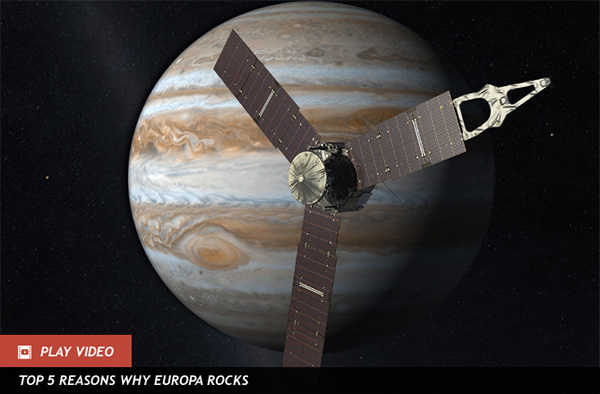NASA Spacecraft is Halfway to Jupiter
Artist’s rendering of Juno approaching Jupiter (NASA/JPL-Caltech)
NASA’s Juno spacecraft has a lot of ground — er, space — to cover before it reaches its ultimate destination at Jupiter in 2016. After two years of travel the spacecraft has officially passed the halfway mark… but first it will need to make one last pass by Earth to pick up a little extra speed.
Jupiter is still a long way off, after all.
“Juno’s odometer just clicked over to 9.464 astronomical units,” said Juno Principal Investigator Scott Bolton, of the Southwest Research Institute in San Antonio. “The team is looking forward, preparing for the day we enter orbit around the most massive planet in our solar system.”
One AU, the average distance from the sun to Earth, is 92,955,807 miles (149,597,870.7 kilometers).
Although the distance from Earth to Jupiter varies from 4.2 to 6.2 AU, depending on where the planets are in their respective orbits, Juno isn’t traveling “as the crow flies.” Instead, it’s making a large loop around the inner solar system, passing far out beyond the orbit of Mars before circling back again to get a gravity-assist from Earth.
“On Oct. 9, Juno will come within 347 miles (559 kilometers) of Earth,” said the mission’s Project Manager Rick Nybakken of JPL. “The Earth flyby will give Juno a kick in the pants, boosting its velocity by 16,330 mph (about 7.3 kilometers per second).
“From there, it’s next stop Jupiter.”
The Juno mission launched from Cape Canaveral AFB on Aug. 5, 2011 at 12:55 p.m. EDT. And, I might add, the ULA Atlas V rocket launch was truly spectacular… I should know, I was there!
As of Aug. 8, 2013, Juno was approximately 36 million miles (58 million kilometers) from Earth. Juno is currently traveling at a velocity of about 23 miles (37 kilometers) per second relative to the sun. Relative to Earth, its speed is about 7 miles (11 kilometers) per second.
Juno has now traveled 874 million miles (1.4 billion kilometers) since its 2011 launch. It will arrive at Jupiter on July 4, 2016, at 7:29 p.m. PDT (10:29 p.m. EDT).
Juno’s goal is to study Jupiter in depth, investigating the giant planet’s powerful magnetic field, atmosphere, and internal structure, coming as close as 3,100 miles (5,000 km). The mission will not only teach us more about Jupiter, the largest and most massive planet in our solar system by far, but also provide insight into the evolution of similar planets orbiting other stars.(Aug 14, 2013 03:57 AM ET // by Jason Major)












